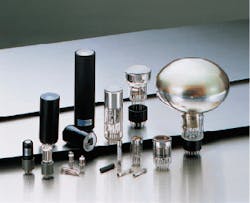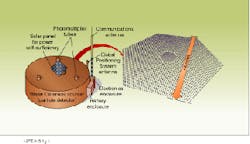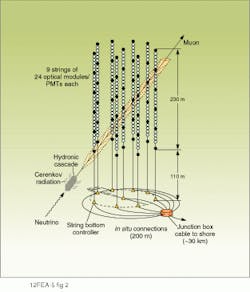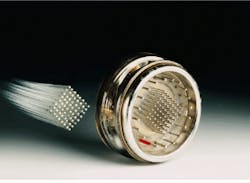Physicists probe particle behavior with PMTs
When light strikes a metal or semiconductor placed within a vacuum, electrons are emitted from its surface. This fundamental phenomenon, known as the external photoelectric effect, serves as the basis for operation in an ubiquitous class of detectors—photomultiplier tubes (PMTs). Photomultiplier tubes are basically vacuum tubes with an input window, a photocathode, and an electron multiplier sealed into an evacuated glass tube. PMTs have fast response times and are sensitive to low light levels, making them widely used in medical and analytical instrumentation, industrial measurement systems, and equipment as diverse as scanners, laser rangefinders, color scanners for printing, plasma monitors, and orbiting telescopes.
A far from exhaustive list of applications calling for PMT detection includes absorption and emission spectrometers, mass spectrometers and surface analyzers, gamma cameras, positron computed tomography or positron emission tomography (PET) scanners, immunoassay methods for clinical and biomedical diagnostics, cell sorters, fluorometers, and DNA sequencers for biotechnology, high-energy physics experiments, and various environmental measurement systems. These and other areas require many thousands of PMTs, and the various configurations and operating characteristics of these detectors are nearly as diverse as the applications themselves (see photo).
Since the first PMT was demonstrated around 60 years ago, much research and development has been devoted to finding new photocathode materials, improve the secondary emission multipliers (dynodes), and create new designs to meet specific requirements. Compact photomultiplier tubes such as the Opto-8 (Hamamatsu, Bridgewater, NJ) are packaged into dime-sized “cans” common throughout the semiconductor industry. Power supply sizes have also been reduced, with the required 1-2 kV packages occupying only a few square inches for some models.
For particular applications, variations in multiplier design can be found. Microchannel plates—bundles of small fibers—can be used, creating a continuous, rather than sequential, dynode configuration. Microchannel-plate PMTs can perform wide bandwidth measurement up to the picosecond regime and can detect low light levels for photon counting applications. Electron multipliers can detect ions, electrons, soft x-rays, and VUV radiation; these devices find applications in mass spectrometers and electron microscopes. Position-sensitive PMTs have been developed to enhance ultrafast response in low-light-level situations. These multianode configuration devices can provide, in one package, the performance of 64 or even 96 PMTs (see “Multichannel PMTs cover spectrum from UV to IR”).
Although scientific, medical, and industrial applications for PMTs have been well documented, their low-light-level performance and sensitivity to radiation from charged particles also make them useful for applications in fundamental physics experiments. For example, an experiment requiring many PMTs to monitor elusive, high-energy cosmic rays has been proposed by two physicists specializing in particle physics.
Looking for cosmic rays on the ground
Nearly four years ago, physicists working with optical cosmic ray detectors located in the western desert of Utah observed the most powerful cosmic ray shower ever detected. Cosmic rays are tiny charged particles that travel at or near the speed of light and can range in size from single protons to heavier configurations such as metal nuclei. This shower of cosmic rays, on the order of millions of electron volts higher than most theories allowed, created a mystery that cosmic ray researchers worldwide are trying to solve. Two years later a similar shower of rays was detected over Japan.
Cosmic rays rain down constantly toward the earth and pass undetected through everything and everyone all the time. The sun or maybe exploding supernovae are thought to be the source of lower-energy rays, but the source of the high-energy rays cannot be explained by current theories. Low-energy rays meet resistance as they move through the atmosphere and lose energy before reaching the ground. The rays that were observed over Utah and Japan rained straight down, leading physicists to believe they could be detected by a monitoring system on the ground.
To search for further showers and to explain their origin, physicists have proposed the $100 million Pierre Auger Observatory, which would involve two detector monitoring sites, each about the size of Delaware, located in yet-to-be-determined desert areas in the Northern and Southern hemispheres. These large detector arrays, arranged in a hexagonal pattern, will consist of 3000 individual pods located about 1.5 miles apart (see Fig. 1). Each pod will contain three PMTs, a solar-powered energy source, a global positioning satellite (GPS) antenna and a communications antenna. A large telescope in the center would scan for bright flashes of light that occur when cosmic rays hit the atmosphere and break up into a shower of particles. When these particles strike a triangular PMT station, the station will interrogate its nearest neighbors to determine if an isolated incident occurred or if the particles are part of a large high-energy shower. When this happens, data will be collected and analyzed.The huge detector grid is required because estimates indicate high-energy cosmic rays fall to earth infrequently at a rate of about one per 100 km2 per year. Project leader James Cronin of the University of Chicago hopes the PMTs on the Pierre Auger Observatory might pick up something like 50 sightings of high-energy cosmic rays each year. The project organizers are in the process of raising funds and choosing sites, and Cronin is optimistic that the 9000 PMTs in it will be operational by the turn of the century.
Looking for neutrinos under the ocean
An example of ongoing fundamental physics research with PMTs is the search for neutrinos in the sea off the coast of Hawaii. Neutrinos are nearly massless, chargeless particles that travel at or near the speed of light. Neutrino astronomy is interesting because these particles can pass through most matter, including the earth, without interaction. Thought to be relics of the Big Bang, neutrinos may come from the interaction of cosmic rays with dust and gas as they pass through the galaxy. High-energy neutrinos, on the order of the cosmic rays described above, are the object of the $10 million undersea PMT-based DUMAND detector project. The Deep Underwater Muon and Neutrino Detector will be located 30 km offshore of the Big Island of Hawaii, with a fiberoptic-cable linking DUMAND to a shore station. Other DUMAND projects are underway at Lake Baikal, Russia, and off the coast of Greece.
Nine strings of 24 PMTs each inside an octagonal cylinder 240 m long and 105 m wide make up DUMAND (see Fig. 2). The cylinder will be lowered 15,750 ft below the surface of the sea, enclosing a volume of more than 2 million metric tons of seawater. The strings are chains of optical modules, each of which contains a 16-in. PMT, associated electronics, and fiberoptic cabling inside a pressure resistant glass sphere and titanium frame. The lowest module will be 110 m above the ocean floor, and the strings will stretch upward for 230 m.Neutrinos will be detected in a complicated process that encompasses the very small probability of their interacting with a quark of the protons in the nuclei of water molecules surrounding DUMAND. Figuring the chances of a neutrino hitting any nucleus in the detector as 1 part in 100 million, University of Hawaii project members estimate that they need 100 million nuclei around to get any interaction. Because the enclosed volume of DUMAND contains about 1036 nuclei, neutrinos should be detected by the muons they produce hitting the quarks. These muons have charge and a mass 200-300 times that of an electron. As they pass through seawater they emit light with a peak wavelength of 400-450 nm. This light is detected as Cerenkov radiation by a PMT. To reconstruct the path of the radiation, signals need to be picked up by six PMTs, and the associated data-processing electronics can measure both the brightness of the radiation and the arrival time (and the charge).
Other astronomers and physicists are joining in neutrino research. In Japan, the Super Kamiokande array is under construction in a deep mine and will be finished next year. Hamamatsu had to build a new factory to assemble the 11,000 large PMTs it is using for neutrino detection. DUMAND is scheduled for completion in 1997, and both of these detector systems should help scientists understand more about the origin of the large numbers of neutrinos thought to exist in the universe.
Multichannel PMTs cover spectrum from UV to IR
The relatively large size of single-channel conventional photomultiplier tubes (PMTs), as well as their sensitivity to magnetic fields, can be a drawback in some of the newer detecting applications. The development of scintillating and wavelength-shifting fibers with diameters of 0.5-2 mm has prompted a need for pixel-sized detectors that can detect signals of one to ten photoelectrons. Avalanche photodiodes (APDs) have been proposed as alternatives, but their noise is often too high for low-light-level applications with scintillating fibers or for positron-emission tomography (PET) scanner arrays, which are composed of very small scintillator rods.
Phototubes will remain the only option for many years, and the Philips Photonics (Brive, France) XP1700 family of multichannel photomultiplier tubes (MC-PMTs) provide one solution to pixel-size detection (see photo). Also known as multianode PMTs or position-sensitive PMTs, these devices include the Hamamatsu (Hamamatsu City, Japan) metal-dynode tube family, electron-bombarded silicon or APD arrays in tubes, promoted by DEP (Roden, the Netherlands), or the similar, but less-developed VAPD from Advanced Photonix (Camarillo, CA). Multichannel versions of microchannel-plate PMTs have been built, but, to date, these devices have limited lifetimes.MC-PMT characteristics
The primary design target of the XP1700 family was to create a low-crosstalk, metal-foil multiplier that had normal PMT characteristics of gain, time response, noise, and linearity. Of importance was the ability to be able to read out all channels in parallel with extremely low crosstalk between pixels. Versions with 64 and 96 channels are available.
The gain of the ten-stage foil multiplier reaches 106 (as in conventional PMTs) at a supply voltage of 1000-1200 V. The gain of the first dynode is high enough to resolve the single photoelectron peak, and the gain spread between pixels in the MC-PMT is approaching the gain spread in a random sample of 64 or 96 conventional PMTs (about 5:1). A typical value of 3:1 seems possible in the near future.
Anode pulse risetime is 5 ns, with an anode pulse width (FWHM) of 8 ns. Proximity focusing and the compactness of the multiplier give a signal transit time of only 15 ns, so the single-electron transit time jitter (FWHM) of a pixel channel is on the order of a nanosecond. These values are all similar to the time response of a conventional PMT.
The anode dark current is typically 5 nA and on the order of 100 pA per pixel at a gain of 106. Dark current is dominated by leakage current rather than thermionic noise from the bialkali photocathode. (These values are slightly higher for S20, S25, and S1 photocathodes, because thermionic noise increases strongly as a result of the lower work functions of these materials.) The pixel pulse-height linearity has been reported to be about 100 pC, which, though less than that of a well-designed linear-focused (large) dynode multiplier, is adequate in most applications.
Crosstalk, a major design parameter, is only 35% from one pixel into all eight neighbors. In the 64-channel staggered-pixel version, in which pixels are further apart in one direction, crosstalk falls to 12%. These values are for 430-nm blue light from a 2-mm-diameter fiber centrally coupled to a 2.54 2.54-mm pixel. Of course, it is possible to reduce crosstalk by using only 32 out of 64 or 48 out of 96 pixels, but at a greatly increased cost per channel.
The predeposited bialkali photocathode has a sensitivity at 400 nm of typically 65 mA/W on glass windows, which is lower than modern values of 80-100 mA/W for in situ cathode processing. Glass window tubes with values approaching 75 mA/W have been made, so we anticipate this will be a typical value in the future. For fiberoptic windows absorbing blue light, this performance will be more difficult to reach. The response of a bialkali cathode falls off sharply in the green side of the spectrum, making it less suitable for wavelength-shifting fiber applications. Philips is introducing an S20 cathode made with transfer technology that has a typical peak sensitivity of 60 mA/W at 500 nm and is useful up to 800 nm. (The cathode thickness is tailored in transfer technology to create what is called a thin S20 cathode; making it gradually thicker results in S25 versions that peak from 550 nm up to 650 nm, with good response up to 900 nm).
Other characteristics include immunity to an axial magnetic field of 80-100 gauss, although the MC-PMTs were not designed to work in strong magnetic fields. The temperature stability is similar to conventional PMTs (~0.3%/°C), and preliminary lifetimes should be around 50-100 coulomb output charge without gain degradation.
The applications for the MC-PMTs are diverse. So far, several clear-glass 96-pixel tubes are on the summit of Gran Sasso, Italy, where they are looking for fast Cherenkov light in the upper atmosphere from ultrahigh-energy gamma rays. At CERN in Geneva, Switzerland, researchers are using MC-PMTs in several scintillating fiber detectors for high-energy physics experiments, and at the University of California, Los Angeles, the devices are used to read out scintillator blocks with clear fibers in a new animal PET scanner and an interoperative probe. A 64-pixel MC-PMT gives enhanced vision in a confocal microscope that scientists are using at the National Institutes of Health (NIH, Bethesda, MD). As more researchers understand the capabilities of MC-PMTs, they will be able to use one detector instead of many in photomultiplier-tube-based experiments.—Esso Flyckt
ESSO FLYCKT covers scientific markets for Philips Photonics, BP520, F-19106 Brive, France. This article is taken from a paper in Proc. SCINT 95 (Delft, the Netherlands) August 1995.
About the Author
Heather W. Messenger
Executive Editor
Heather W. Messenger (1955-1998) was Executive Editor for Laser Focus World.



